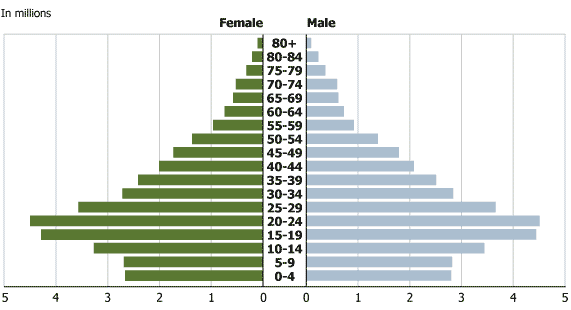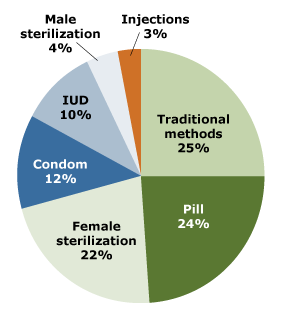
Youth, Women's Rights, and Political Change in Iran
Date
July 13, 2009
Author
(July 2009) Recent political developments in Iran highlight the country’s demographic and social shifts over the past 20 years. One in three Iranians is between the ages of 15 and 29. Furthermore, 60 percent of the Iranian population is under 30, born around the 1979 Islamic revolution or after(see Figure 1).1 This youth bulge, along with changes in women’s fertility and reproductive health, provide a backdrop for understanding Iran’s current political instability.
Figure 1
Iran Age and Sex Distribution, 2006 
Source: Statistical Center of Iran.
Fertility Decline and Organized Family Planning
The youth bulge is more evident in Iran than any other country in the world because Iran has experienced the fastest fertility decline in the last two decades or so, according to a recent United Nations report (see Table A.14). According to the Iranian Ministry of Health and Medical Education, fertility declined by more than two-thirds, from 6.6 births per woman in the mid-1970s to about 2.0 births per woman in 2006. The most surprising and impressive decline occurred in rural areas. In one generation (a period of about 30 years), Iranian women living in rural areas moved from giving birth to an average of eight children to around two children.
Iran’s Falling Fertility Rate By Area For Selected Years, 1977-2006
|
Births per Woman
|
||||
|---|---|---|---|---|
| 1977 | 1996 | 2000 | 2006 | |
| Urban | 4.5 | 2.2 | 1.8 | 1.8 |
| Rural | 8.1 | 3.5 | 2.4 | 2.1 |
| Total | 6.6 | 2.8 | 2.0 | 1.9 |
Source: Iranian Ministry of Health and Medical Education.
The rapid decline in the total fertility rate coincided with the revival of the national family planning program, delivered free through a nationwide network of primary health care facilities. Without banning the use of modern contraception altogether, the Islamic government dismantled Iran’s national family program soon after the 1979 revolution because it was viewed as a Western innovation. But about 10 years later, the government saw high fertility and rapid population growth as obstacles to the country’s security and economic development, and established one of the most successful family planning programs in the world.
Today, nearly 80 percent of married women of reproductive age use family planning; 75 percent of them use a modern method (see Figure 2). More important, the gap in modern contraceptive use has closed between rural and urban Iran, as women across the country have gained access to free counseling and services for all modern contraceptive methods. In fact, the only condom factory in the region is in Iran.
Figure 2
Distribution of Iranian Women (Married of Reproductive Age) Using Contraception, by Method

Source: Iranian Ministry of Health and Medical Education.
The Push for Women’s Rights
Having achieved their reproductive rights, Iranian women are now at the forefront of movements in the country that demand more rights and equality for all its citizens. For the first time the issue of women’s rights became a major topic in political campaigns during the 2009 presidential election. Recognizing the key role that women voters—younger women in particular—play in the election, presidential candidates were obliged to go beyond slogans that emphasize high cultural and religious value placed on women as wives and mothers, and specifically address the demands voiced by women’s rights activists.
Social norms that discriminate against women exist worldwide. What separates Muslim countries such as Iran is the fact that discrimination based on gender is codified in laws and the legal system. The most notable areas of discrimination against women in Iran are family codes related to issues such as child custody and divorce, the judiciary system—where women are barred from serving as judges—and the political system that bars women from running in presidential elections or being nominated for positions in the country’s highest political bodies.
However, Iranian women have been an accelerating force for development in Iran, as manifested in their fertility behavior and desire to improve their life. The average age of marriage for women in Iran has risen to 23 years, partly because more women are in school now and for a longer period of time. In fact, there are more women than men in Iranian universities. Amazingly, today the average age of marriage for women living in urban areas is the same as that of those living in rural areas, where 32 percent of Iran’s population lives. Even more astonishing is that a higher percentage of rural women remain single. According to 2006 census data, among women ages 30 to 34, 15 percent of those living in rural areas were never married, compared with 10 percent of those living in urban areas.2
These changes in marriage patterns are confronting deeply rooted cultural values of certain segments of the population and the government that are trying to hold on to past traditions of early and universal marriage, creating social and psychological frustrations among young people. There have been reports of relatively high rates of suicides among young, unmarried women living in more conservative provinces, such as Ilam.
In an effort to narrow the gaps between the needs and realities of their daily lives and Iran’s legal system, women’s movements are evolving and strengthening. The One Million Signatures Campaign is the most well-known, grassroots effort. Its door-to-door campaign aims to raise awareness about the negative impact of some laws on the lives of women and their children through face-to-face discussions and by seeking 1 million signatures in support of a petition addressed to the Iranian parliament asking that discriminatory laws be reformed.
The Aspirations and Challenges of Iran’s Youth
The uprising following the disputed presidential election of June 12, 2009, is a manifestation of underlying frustrations. Social and political restrictions, coupled with high rates of unemployment and costs of living, have made it increasingly difficult for young Iranians, pushing them to leave the country in large numbers to find jobs in places such as Canada and Australia. The cost to Iran for losing its human capital is estimated at billions of dollars a year. The unemployment rate for young people ages 15 to 24 is 23 percent, twice that of the total labor force. Finding a job is even more challenging for young women. One in three young Iranian women in the labor force (defined as either working or looking for a job) is unemployed, even though women comprise only 17 percent of the labor force in Iran.3
Countries such as Iran with a large working-age population relative to younger and older populations who depend on the working-age population can benefit from their “demographic dividend.” Whether Iran will manage to reap these benefits depends on how well the country is equipped to expand its economy to bring in more women into the labor force and create jobs for its rapidly expanding and mostly educated labor force.
Farzaneh (Nazy) Roudi is program director, Middle East and North Africa, at the Population Reference Bureau.
References
- Statistical Center of Iran, Year Book Selected Data, accessed online at www.sci.org.ir/portal/faces/public/sci_en, on June 22, 2009.
- Iranian Ministry of Health and Medical Education, personal communication, June 15, 2009.
- Statistical Center of Iran, Labor Force Indicators, accessed online at www.sci.org.ir/portal/faces/public/sci_en, on June 22, 2009.
